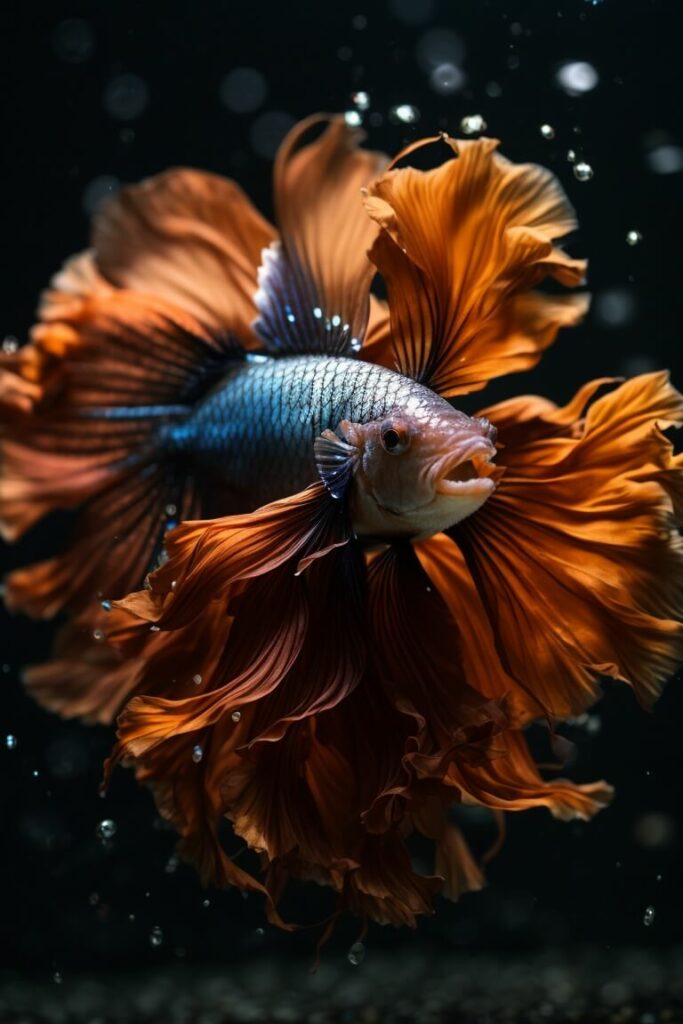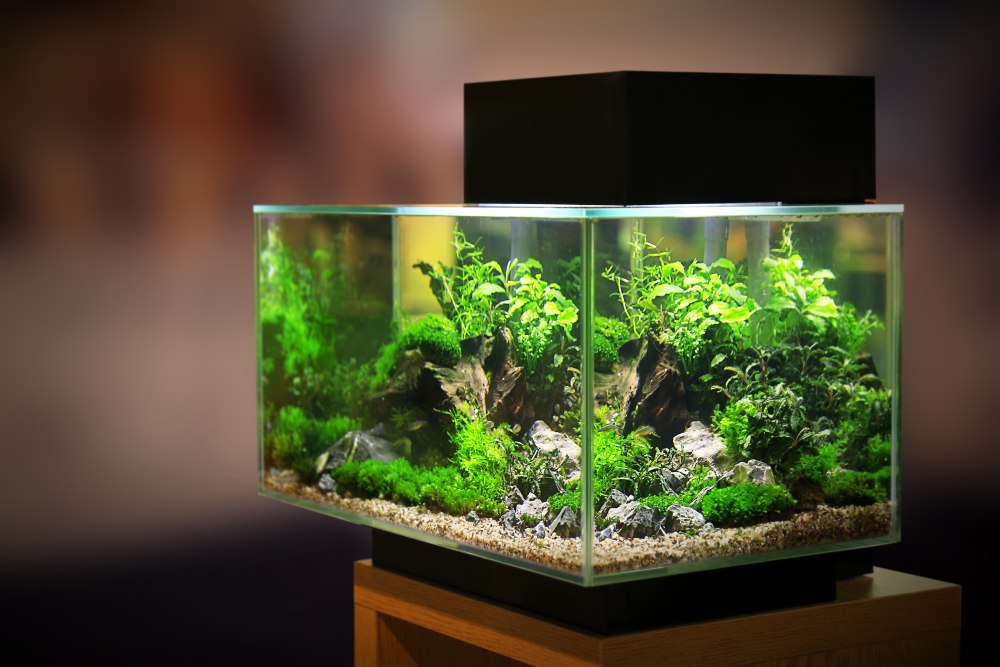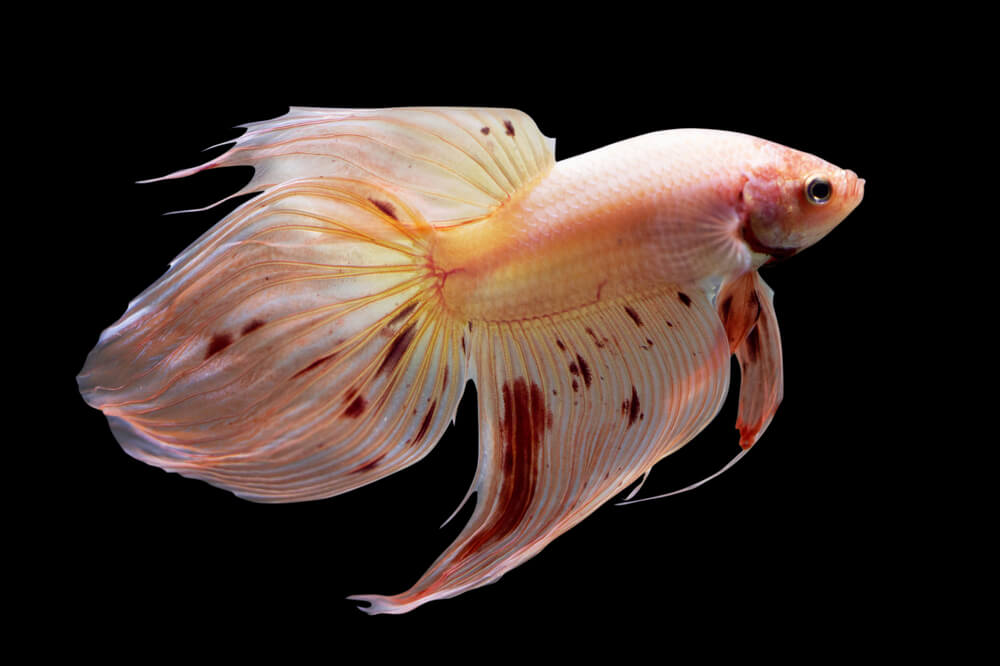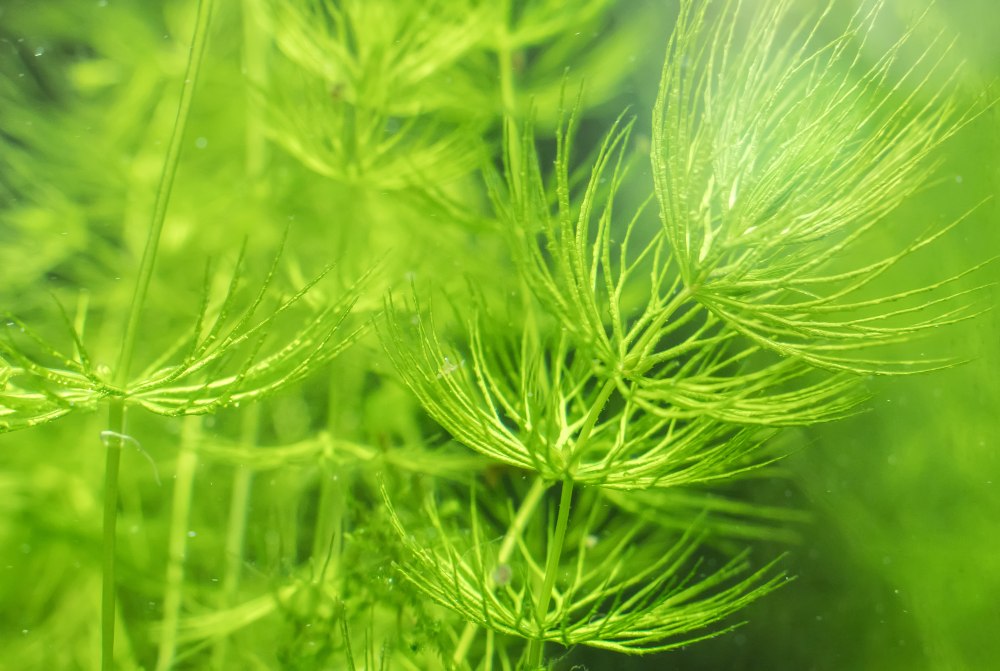Did you know there are more than 73 species of betta fish?
The Siamese fighting fish has many cousins, one being the veiltail betta.
The beautiful features of these bettas make them an aquarium favorite. But before you rush out to buy yourself one of these fancy bettas, let’s take some time getting to know this freshwater fish.
| Veiltail betta overview | |
| Lifespan | 2 to 5 years |
| Length | 1.5 to 2 inches |
| Appearance | Complex mix of colors due to their 4 different color layers of cells |
Veiltail betta fish: origin, identification and temperament

Veiltail bettas come from the betta Splendens family. They have gorgeous fins that resemble a bridal veil, which is why they came to be known as veiltail betta.
The home to these freshwater fish is Southeast Asia, where they are commonly found in rice paddies, pits, shallow water streams, and the like.
Veiltail betta was first identified years ago in 1927. These beautiful fish are the result of selective breeding. The unique features that set veiltail betta fish apart from other bettas are the long asymmetrical caudal fin drooping downward that looks like a bridal veil.
Veiltail bettas have very vibrant colors due to four different color layers of cells within the skin. The fish has iridescent pigment cells on the top layer, which is followed by a red layer. The third layer is black, while the fourth and final one is a yellow layer.
You’ll find veiltail betta fish in blue, red, yellow, purple, and other colors. The complex mix of colors varies based on what color fish you have picked. In some, the top layer will have a more concentrated red pigment, while in some others, it’ll have a more concentrated blue pigment.
Out of all, blue veiltail bettas are more common in pet stores, and they are a popular choice among fish keepers as well. The veiltail bettas can live between two and five years, and grows to be about 1.5 inches to 2 inches in length.
The obvious difference between a male betta and a female veiltail betta is their body color. The male bettas have a brighter body than female bettas. Moreover, the males have slightly longer fins while the females have short fins. The males also have a triangular body shape, while females have a plump, oval shape.
Another factor that helps distinguish between the male fish and the female betta is the ovipositor. It’s the organ that females use to lay eggs.
The male veiltail betta, like any other betta species, has an aggressive nature. They are quite protective of their territory and usually can’t tolerate invaders. The female veiltail betta has a calmer nature compared to its male counterpart, but will still become aggressive when threatened.
Betta fish are generally solitary fish, so they prefer to live alone.
Taking care of the veiltail betta
Taking proper care of the veiltail betta is important if you want to see healthy fish thriving in the tank. Betta fish are very sensitive to their living environments and can’t adjust outside their comfort zone, so you have to make sure you mimic their natural habitat in the fish tank as close as possible.
In this section, we’ll tell you how you can provide a proper tank environment for your beautiful veiltail fish and keep it protected from disease and stress.
Tank size

Bettas need big tanks. These are not like other aquarium fish that can live in a fishbowl or vase. You need a five gallon tank at minimum to house one single veiltail betta. If you keep more than one fish, you have to size up. The same is applicable to community tanks.
We would suggest you get at least a ten gallon tank if the betta fish is kept in a shared tank. These will give the tropical fish enough space and will keep the other fish away from its sight.
Don’t fill the tank till the brim. Bettas are labyrinth fish, so they use their labyrinth organ to take oxygen from both air and water. They often swim up the water’s surface to take the air, so filling the tank to the top might make the fish feel suffocated.
Water parameters

Water parameters are the most important factor to keep veiltail bettas healthy. These fish are very sensitive to water conditions, so you must house them in a tank with similar water parameters to their natural homes.
The water temperature should be between 75-81 degrees Fahrenheit and try to keep the tank temperature the same at all times. Bettas can’t adjust to sudden temperature changes, so they can easily die of temperature shock.
The pH level should never exceed 7.5; the ideal range is 6.8 to 7.5. Again, the carbon hardness has to be between 3 to 5 dKH, and the general hardness should be between 3 to 4 DGH. The general hardness refers to the concentration of calcium and magnesium ions dissolved in tank water.
Water filter
You have to keep the betta tank clean at all times; otherwise, the fish will fall ill or even die. The ammonia and nitrate levels should always be within the ideal range, which is close to zero. A good aquarium filter is, therefore, a must to maintain tank conditions.
A good filter will keep the water ammonia and nitrate free, which otherwise can lead to fin rot or other skin-related issues. But don’t keep very strong filters in the aquarium. Bettas are used to living in slow water movement, so a filter with a strong current will stress out the veiltail betta, plus it may damage its delicate fins.
Additionally, you’ll have to use a heater to maintain the water temperature since these fish need warmer water, so keeping a heater inside the aquarium is a must. Although the water filter does a great job maintaining water quality, a betta fish tank needs proper cleaning and water change at regular intervals.
For instance, you have to change 20% tank water every week even if you have a filter. If you don’t have a filter, you should change 30% to 50% of the water weekly. Just make sure to never change 100% of the water as it will stress out your betta fish and can cause them to go into shock.
Tank decorations

You are not supposed to house veiltail bettas or any other bettas in an empty tank. These little guys love interacting with their surrounding environment, so you have to pay equal attention to the tank decors as well.
Veiltail betta fish is originally from the tropical Southeast Asian waters with very thick vegetation, so they would expect the same in the tank environment as well. You have to use lots of live plants, silk plants, and aquarium substrates.
For plants, consider using Indian almond leaves as these make the tank look good, but these have anti-microbial and anti-inflammatory properties that will help lower the water’s pH level. Betta fish also like making bubble nests under almond leaves, so they serve multiple purposes.
Other plants to add to the betta tank are java fern, java moss, Anubias or water sprite. You can add some betta hammocks as well to let the fish rest or sleep upon.
For substrates, use small pebbles, sands, and a few other common aquarium decorative items. But make sure not to keep any sharp-edged objects. Sharp objects or fake plants can easily damage the flowing fins of the veiltail betta fish.
Food
Veiltail bettas are carnivorous. In their natural homes, bettas survive on invertebrates, small insects, and tiny fish. To keep up with your Siamese fighting fish’s original diet, you have to provide them protein rich food.
A healthy diet for veiltail betta should have high-quality betta pellets, and live food like blood worms, brine shrimp, daphnia, frozen bloodworms, mosquito and insect larvae.
But remember that veiltail bettas don’t need too much food.
Their small stomachs can’t handle large amounts of food, and you should only feed your betta fish one or two times per day.
You must keep at least a twelve hours gap between each meal. Feeding earlier than that may make the fish bloated. Overeating is also dangerous as it leads to diseases like constipation, lethargy, and bulging eyes. If not controlled, it may also kill your veiltail betta fish.
Tank mates
Tank mates for Siamese fighting fish are limited, but there are a few other fish you can add into your betta’s tank.
First, you should never house two male bettas in the same tank. Two male bettas don’t make compatible tank mates and they’ll fight till death.
You can try pairing a male and a female betta. But always observe their behavior carefully. The male may get aggressive at any time, hurting his female partner.
If you are keeping the veiltail betta with any other fish or other aquatic animals, be mindful of the size, color, and behavior of the other species. Bettas will never prefer a tank mate that seems threatening to it.
Aquatic species like neon tetras, African dwarf frogs, ghost shrimp, Amano shrimp, cherry shrimp, small corydoras, and guppies make wonderful tank mates for betta fish.
Breeding
When the veiltail betta reaches about six months, it gets ready for spawning.
The breeding pair won’t mate in the presence of other fish, so they should be given their own tank. Get a female that’s smaller than the male betta. If the female is the same size as the male, he would most likely attack her, considering her a threat.
When the female gets ready for mating, her body becomes darker, and there are visible white stripes on it. The female gives mating signals by waving her veil tail in the male’s direction.
When the pair gets ready for breeding, the male veiltail betta makes a bubble nest under the floating plants. The mating takes place under the bubble nest, and when the female lays eggs, the male betta carries them to the bubble nests.
The eggs take two to three days to hatch; until then, the male takes sole responsibility for protecting them. After hatching, the baby bettas stay inside the shell for another two days only, after which they get ready to swim.
All betta varieties have the habit of eating their own fry, and it’s no exception with the veiltail betta. To keep the little fry safe, you should immediately separate the parent bettas from the breeding tank.
Conclusion
Veiltail bettas will make a beautiful addition to your home aquarium. Although they require a specific tank environment, veiltail betta fish are relatively easy to care for. Make sure to pay enough attention to their tank conditions, food quality, and quantity, and your veiltail betta will thrive in the aquarium.
If there is anything more you want to learn about veiltail bettas, make sure to leave a comment below.

